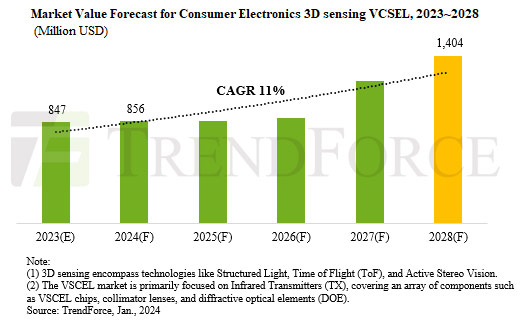News: Markets
11 January 2024
Consumer electronics 3D sensing VCSEL market to rebound at 11% CAGR to $1.404bn in 2028
According to the latest report ‘TrendForce 2024 Infrared Sensing Application Market and Branding Strategies’, the market for consumer electronics 3D sensing vertical-cavity surface-emitting lasers (VCSELs) fell to US$847m in 2023 due to weak consumer demand and pricing pressure.
Major brands incorporating 3D sensing in their 2023 consumer electronics include Apple (smartphones and tablets), Honor (smartphones), Meta Quest 3, and Magic Leap 2. The iPhone 15 Pro, featuring Sony’s stacked technology, integrates a VCSEL/drive IC and SPAD/ISP (ASIC chips) in a compact stack. This not only reduces system size but also enhances the performance of light detection & ranging (LiDAR) scanners at the same power level — extending battery life and improving camera and augmented-reality (AR) functionalities.
Major Apple developments include the adoption of MetaLenses in 2024 to minimize the size of transmitters. Furthermore, the company intends to implement under-display 3D sensing by 2027 to increase display-screen ratios. This technology, using a short-wave infrared (SWIR) VCSEL, reduces interference from sunlight and ambient light while mitigating white-spot phenomena. The adoption of SWIR VCSELs is expected to drive VCSEL prices up. TrendForce research indicates that ams OSRAM’s 1130nm VCSEL demonstrates superior performance by achieving power conversion efficiency (PCE)>30% in second-half 2023.

The upcoming 2024 launch of the Apple Vision Pro, equipped with a trio of cutting-edge 3D sensing technologies — Structured Light, Direct Time of Flight (dToF), and Active Stereo Vision — is poised to significantly propel the 3D sensing market, notes TrendForce. This growth trajectory is further bolstered by the sustained introduction of AR and VR products from tech giants like Sony, Meta, Microsoft and Google. As a result, the consumer electronics 3D sensing VCSEL market is forecasted to rise at a compound annual growth rate (CAGR) of about 11% from 2023 to US$1.404bn in 2028.









